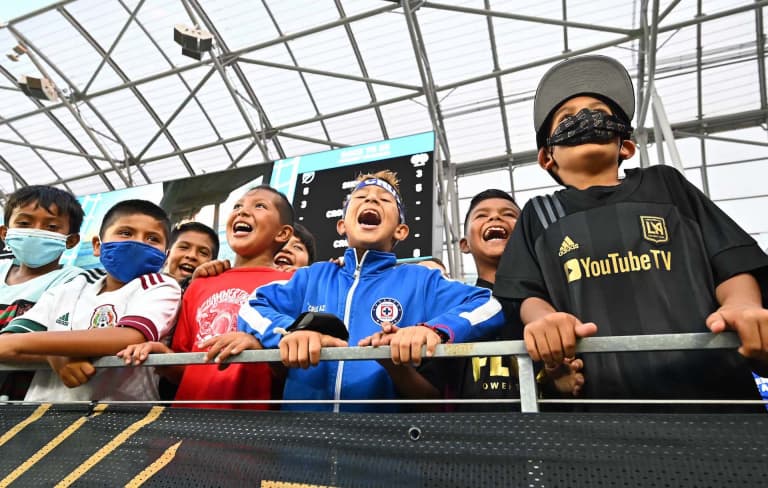LOS ANGELES – Type “2021 MLS All-Star Game” and “rivalry” into your search engine of choice, and you will not lack results.
Last time I checked, there were upwards of 5,000 hits on such a query, and this here website is no small contributor to that. It’s natural and unavoidable given the history between MLS and Liga MX, as well as the context of the competition among Canada, Mexico and the United States. You may have noticed, they're three of the eight nations set to tussle for Concacaf’s precious three automatic qualification slots for next year’s World Cup.
That’s a key driver behind the appeal of Wednesday night's 2021 MLS All-Star Game presented by Target (9 pm ET | FS1, Univision in US; TSN, TVA Sports in Canada), as players and coaches on both sides have acknowledged and embraced. But it’s not the whole story.
Just as we’ve seen the old enmity between the US men’s national team and their El Tri counterparts evolve in recent years amid a steady stream of dual-eligible players and fans with roots in both sides, so has the wider relationship between these nations and their soccer ecosystems. These old enemies are now more like siblings, and this year’s Southern California setting epitomizes it.
Take a walk around Banc of California Stadium during Tuesday night’s All-Star Skills Challenge presented by AT&T 5G and you’d see spectators of all ages clad in jerseys of the USMNT, Mexico, LAFC, Chivas Guadalajara, the LA Galaxy, Santos Laguna – often with contrasting loyalties in the same families and gaggles of friends. It doesn’t stop the jeering and smack talk (far from it, in fact), but the spite and viciousness of the old days, the sheer alienating otherness, has faded in subtle yet telling ways.
“Their soccer is in total evolution, with a lot of growth,” Cruz Azul and Liga MX All-Stars manager Juan Reynoso said of MLS on Monday. “It is no coincidence that they have more players in Europe. That is why it is important that the leagues join. The Mexican league has maintained a good level for longer and the American one is growing … I think [MLS] is having an important natural growth with the arrival of new talents in addition to the contribution of its own.”
The son of Club América-supporting Mexican immigrants from neighboring Ciudad Juarez, FC Dallas wunderkind Ricardo Pepi grew up in a Liga MX-centric household in El Paso. But he found his professional path in Frisco, relocating to north Texas and developing talents so eye-catching that he now finds himself heavily wooed by both countries, presenting him with a gripping decision of national-team allegiance.

One of the colleagues he was most excited to rub shoulders with in LA is Rodolfo Pizarro, who earned dozens of Mexico caps as a Liga MX standout, but embraced his multi-million-dollar move to Inter Miami CF last year, happy to carry the banner north on a new adventure like Carlos Vela and Javier "Chicharito" Hernandez before him. Others will surely follow in the coming years.
“Being so close and having so many competitions between them have improved each other,” Lucas Zelarayan, an Argentine who played for Tigres UANL before becoming the Columbus Crew's attacking linchpin last year, said of the two nations.
Decades of Concacaf Champions League clashes, World Cup qualifiers and international friendlies grew familiarity, then cross-pollination. MLS realized how much could be gained by increasing roster spending and ambition along the lines of Liga MX, how profound the relationship is between the Mexican diaspora and their teams back home. And it's gained a deeper appreciation for how deep the passion and talent for the game runs among the Hispanic communities across the United States — and how costly it can be to overlook or fail to connect those Americans.
In turn, Mexico’s footballing hierarchy grasped the enormous potential to the north, the value of the organizational and promotional nous their opposite numbers in MLS had cultivated, how intertwined were the fortunes of the continent’s two giants, how rapidly the gap in quality was closing. And now we see a relationship that's far more than just mutual enmity in a zero-sum scenario.
“Whenever we have players in Mexico or dual-national players or now Mexican players in MLS, it connects dots, and it’s important,” said MLS All-Stars coach Bob Bradley on Tuesday, drawing a straight line from this week’s spectacle to the ongoing quest to make the US and Canadian games more inclusive, more universal beyond the old perceptions of a sport for bourgeois suburbanites in minivans.
“For the game in our country to continue to grow, everybody's heard me saying that we need to make sure that that we reach into all neighborhoods, and make people feel like they're part of the game.
“And I think these types of experiences just help make sure that we’re improving in those ways, because maybe in the past some people would say that part hasn't gone well enough, that players from different backgrounds don't get the same type of opportunities. Again, moving forward, that part has to be an area where we're all on board, that if you grow up in this country, no matter what neighborhood you grow up in, no matter what your background, the game is open for you and we do a really good job of finding talent and bring that talent forward when possible.”
We might have to wait years, even decades to see if the mooted fusion of these two leagues will ever reach reality. But the lines are already blurring, the proverbial DNA mingling. And that bodes well for both sides.












